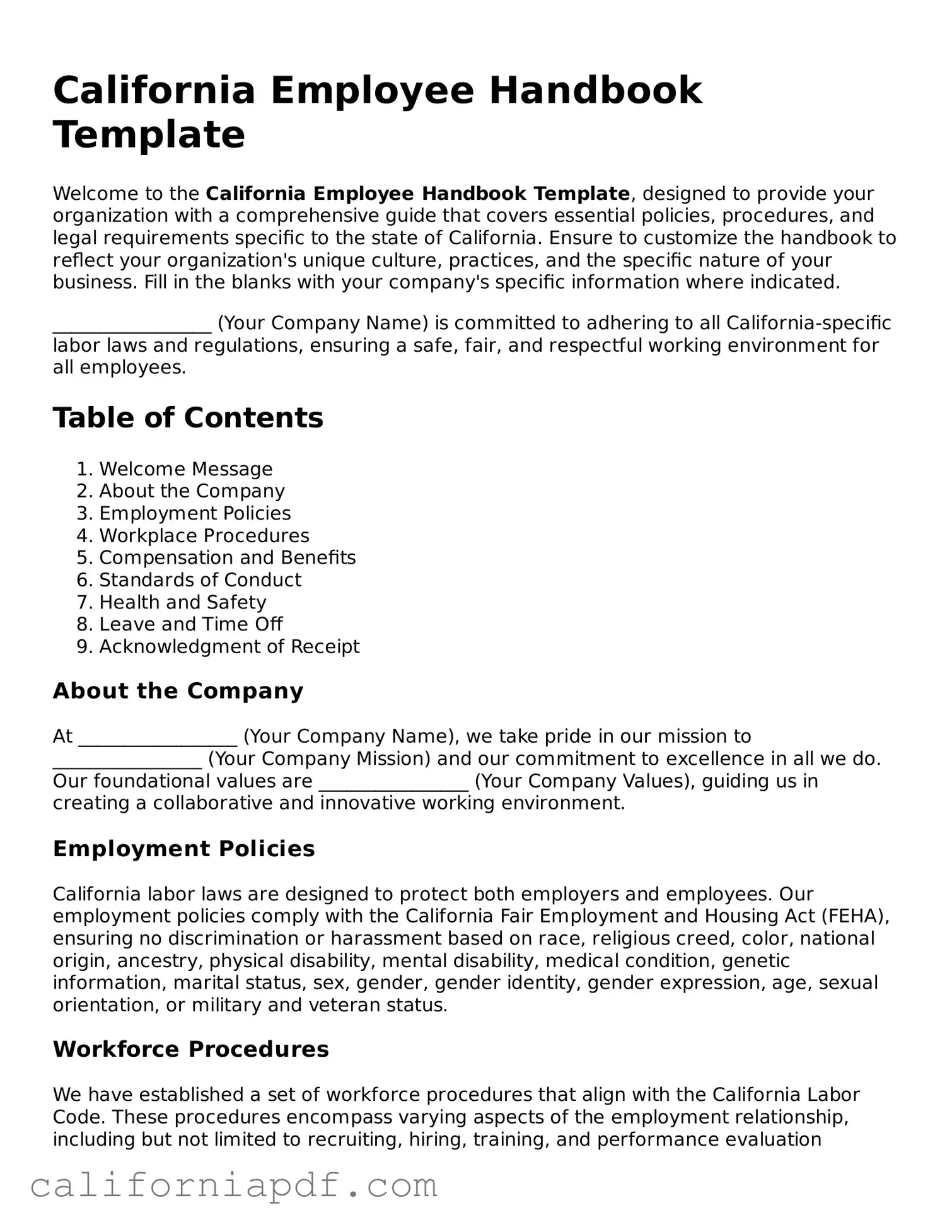California Employee Handbook Template
Welcome to the California Employee Handbook Template, designed to provide your organization with a comprehensive guide that covers essential policies, procedures, and legal requirements specific to the state of California. Ensure to customize the handbook to reflect your organization's unique culture, practices, and the specific nature of your business. Fill in the blanks with your company's specific information where indicated.
_________________ (Your Company Name) is committed to adhering to all California-specific labor laws and regulations, ensuring a safe, fair, and respectful working environment for all employees.
Table of Contents
- Welcome Message
- About the Company
- Employment Policies
- Workplace Procedures
- Compensation and Benefits
- Standards of Conduct
- Health and Safety
- Leave and Time Off
- Acknowledgment of Receipt
About the Company
At _________________ (Your Company Name), we take pride in our mission to ________________ (Your Company Mission) and our commitment to excellence in all we do. Our foundational values are ________________ (Your Company Values), guiding us in creating a collaborative and innovative working environment.
Employment Policies
California labor laws are designed to protect both employers and employees. Our employment policies comply with the California Fair Employment and Housing Act (FEHA), ensuring no discrimination or harassment based on race, religious creed, color, national origin, ancestry, physical disability, mental disability, medical condition, genetic information, marital status, sex, gender, gender identity, gender expression, age, sexual orientation, or military and veteran status.
Workforce Procedures
We have established a set of workforce procedures that align with the California Labor Code. These procedures encompass varying aspects of the employment relationship, including but not limited to recruiting, hiring, training, and performance evaluation processes. All employees are encouraged to familiarize themselves with these procedures to understand their rights and responsibilities.
Compensation and Benefits
Our compensation and benefits packages are designed to be competitive and compliant with the minimum wage laws as outlined in the California Labor Code. Benefits may include health insurance, retirement savings plans, paid time off, among others, and are subject to eligibility and company policies.
Standards of Conduct
Maintaining a professional work environment that respects individual differences and promotes the safety and well-being of all employees is paramount. The Standards of Conduct provide guidelines for acceptable behavior at _________________ (Your Company Name) and include policies on workplace harassment, violence, and ethics.
Health and Safety
Your safety is our top priority. In compliance with the California Occupational Safety and Health Act (Cal/OSHA), we are committed to providing a safe and healthy workplace for all employees. This section outlines the responsibilities of both employees and management in maintaining a safe work environment, including reporting accidents, injuries, and unsafe conditions.
Leave and Time Off
We recognize the importance of balance between work and personal life. In alignment with the California Family Rights Act (CFRA) and other state-specific leave laws, we provide various leave options to our employees, including but not limited to, family and medical leave, pregnancy disability leave, and paid sick leave.
Acknowledgment of Receipt
Employees are required to acknowledge that they have received, read, understand, and agree to comply with the content of this Employee Handbook. A signed acknowledgment receipt should be returned to the Human Resources Department and will be kept in the employee's personnel file.
For additional information or clarification on any of the policies contained within this handbook, employees are encouraged to contact the Human Resources Department.
